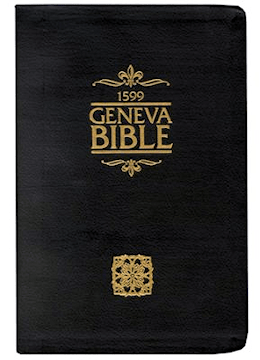Textus Receptus Bibles
Geneva Bible 1560/1599
| 9:1 | And Dauid sayde, Is there yet any man left of the house of Saul, that I may shew him mercie for Ionathans sake? |
| 9:2 | And there was of the housholde of Saul a seruant whose name was Ziba, and when they had called him vnto Dauid, the King sayd vnto him, Art thou Ziba? And he sayd, I thy seruant am he. |
| 9:3 | Then the King sayd, Remayneth there yet none of the house of Saul, on whome I may shewe the mercie of God? Ziba then answered the King, Ionathan hath yet a sonne lame of his feete. |
| 9:4 | Then the King said vnto him, Where is he? And Ziba said vnto the King, Behold, he is in the house of Machir ye sonne of Ammiel of Lo-debar. |
| 9:5 | Then King Dauid sent, and tooke him out of the house of Machir the sonne of Ammiel of Lo-debar. |
| 9:6 | Nowe when Mephibosheth the sonne of Ionathan, the sonne of Saul was come vnto Dauid, he fel on his face, and did reuerence. And Dauid sayde, Mephibosheth? And he answered, Beholde thy seruant. |
| 9:7 | Then Dauid sayd vnto him, Feare not: for I wil surely shewe thee kindnes for Ionathan thy fathers sake, and will restore thee all the fieldes of Saul thy father, and thou shalt eate bread at my table continually. |
| 9:8 | And he bowed himselfe and sayd, What is thy seruant, that thou shouldest looke vpon such a dead dog as I am? |
| 9:9 | Then the king called Ziba Sauls seruant, and said vnto him, I haue giue vnto thy masters sonne all that perteined to Saul and to all his house. |
| 9:10 | Thou therefore and thy sonnes and thy seruantes shall till the lande for him, and bring in that thy masters sonne may haue foode to eate. And Mephibosheth thy masters sonne shall eate bread alway at my table (nowe Ziba had fifteene sonnes, and twentie seruants) |
| 9:11 | Then sayd Ziba vnto the King, According to all that my lord the King hath commaded his seruant, so shall thy seruat do, that Mephibosheth may eate at my table, as one of the Kings sonnes. |
| 9:12 | Mephibosheth also had a yong sonne named Micha, and all that dwelled in the house of Ziba, were seruants vnto Mephibosheth. |
| 9:13 | And Mephibosheth dwelt in Ierusalem: for he did eate continually at the Kings table, and was lame on both his feete. |

Geneva Bible 1560/1599
The Geneva Bible is one of the most influential and historically significant translations of the Bible into English, preceding the King James translation by 51 years. It was the primary Bible of 16th century Protestantism and was the Bible used by William Shakespeare, Oliver Cromwell, John Knox, John Donne, and John Bunyan. The language of the Geneva Bible was more forceful and vigorous and because of this, most readers strongly preferred this version at the time.
The Geneva Bible was produced by a group of English scholars who, fleeing from the reign of Queen Mary, had found refuge in Switzerland. During the reign of Queen Mary, no Bibles were printed in England, the English Bible was no longer used in churches and English Bibles already in churches were removed and burned. Mary was determined to return Britain to Roman Catholicism.
The first English Protestant to die during Mary's turbulent reign was John Rogers in 1555, who had been the editor of the Matthews Bible. At this time, hundreds of Protestants left England and headed for Geneva, a city which under the leadership of Calvin, had become the intellectual and spiritual capital of European Protestants.
One of these exiles was William Whittingham, a fellow of Christ Church at Oxford University, who had been a diplomat, a courtier, was much traveled and skilled in many languages including Greek and Hebrew. He eventually succeeded John Knox as the minister of the English congregation in Geneva. Whittingham went on to publish the 1560 Geneva Bible.
This version is significant because, it came with a variety of scriptural study guides and aids, which included verse citations that allow the reader to cross-reference one verse with numerous relevant verses in the rest of the Bible, introductions to each book of the Bible that acted to summarize all of the material that each book would cover, maps, tables, woodcut illustrations, indices, as well as other included features, all of which would eventually lead to the reputation of the Geneva Bible as history's very first study Bible.